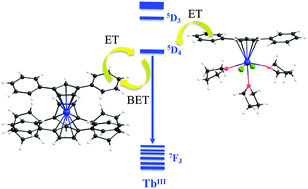The role of the excited state dynamic of the antenna ligand in the lanthanide sensitization mechanism†
Abstract
A fragmentation scheme combined with a series of theoretical approximations like TD-DFT, and multiconfigurational CASSCF/NEVPT2 methods, has been used to describe the photophysical phenomena associated with the antenna effect and lanthanide ion emission. The theoretical protocol was used in (Cp2Ph)3Tb and (Cp2Ph)TbCl2(THF)3, where Cp2Ph = diphenylcyclopentadienyl and THF = tetrahydrofuran, organometallic complexes recently reported by Roitershtein et al. (Inorg. Chem., 2018, 57, 10199) The excited-state dynamic of the antenna ligand shows an important vibronic coupling associated with the radiative and non-radiative process with rate constants in the order normally reported for organic molecules. The methodology proposed herein allows a justification of the back-energy transfer observed experimentally in the (Cp2Ph)3Tb complex and the efficient energy transfer mechanism in (Cp2Ph)TbCl2(THF)3, thus proving to be a robust tool in the determination of the sensitization pathways in organometallic lanthanide complexes.



 Please wait while we load your content...
Please wait while we load your content...